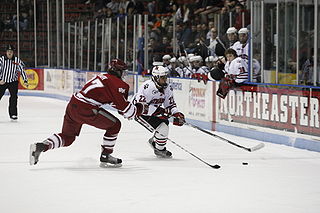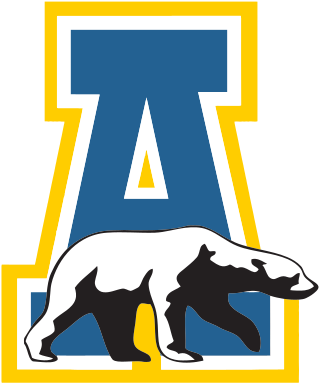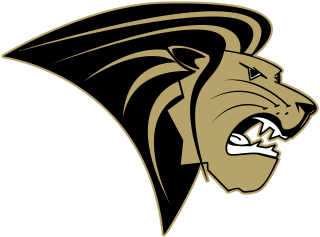
The National Collegiate Athletic Association (NCAA) is a nonprofit organization that regulates student athletics among about 1,100 schools in the United States, and one in Canada. It also organizes the athletic programs of colleges and helps over 500,000 college student athletes who compete annually in college sports. The headquarters is located in Indianapolis, Indiana.

NCAA Division I (D-I) is the highest level of intercollegiate athletics sanctioned by the National Collegiate Athletic Association (NCAA) in the United States, which accepts players globally. D-I schools include the major collegiate athletic powers, with large budgets, more elaborate facilities and more athletic scholarships than Division II and Division III as well as many smaller schools committed to the highest level of intercollegiate competition.

NCAA Division II (D-II) is an intermediate-level division of competition in the National Collegiate Athletic Association (NCAA). It offers an alternative to both the larger and better-funded Division I and to the scholarship-free environment offered in Division III.

The Central Atlantic Collegiate Conference is a college athletic conference affiliated with the National Collegiate Athletic Association (NCAA) at the Division II level. Its twelve member institutions are located in the northeastern United States in the states of Connecticut, Delaware, New Jersey, New York, and Pennsylvania.

The Northeast-10 Conference (NE-10) is a college athletic conference affiliated with the National Collegiate Athletic Association (NCAA) at the Division II level. Member institutions are located in the northeastern United States in the states of Connecticut, Massachusetts, New Hampshire, New York, and Vermont. It is the only Division II collegiate ice hockey conference in the United States.
NCAA Division I independent schools are four-year institutions that compete in college athletics at the NCAA Division I level, but do not belong to an established athletic conference for a particular sport. These schools may however still compete as members of an athletic conference in other sports. A school may also be fully independent, and not belong to any athletic conference for any sport at all. The reason for independent status varies among institutions, but it is frequently because the school's primary athletic conference does not sponsor a particular sport.

The Clarkson Golden Knights are composed of 20 teams representing Clarkson University in intercollegiate athletics, including men and women's alpine skiing, basketball, cross country, ice hockey, lacrosse, nordic skiing, soccer, and swimming. Men's sports include baseball and golf. Women's sports include softball and volleyball. The Golden Knights compete in the NCAA Division III and are members of the Liberty League for all sports except ice hockey, which competes in NCAA Division I, as a member of ECAC Hockey.

College ice hockey is played principally in the United States and Canada, though leagues exist outside North America.

The Navy Midshipmen are the athletic teams that represent the United States Naval Academy. The academy sponsors 36 varsity sports teams and 12 club sport teams. Both men's and women's teams are called Navy Midshipmen or Mids. They participate in the NCAA's Division I, as a non-football member of the Patriot League, a football-only member of the American Athletic Conference in the Football Bowl Subdivision (FBS), and a member of the Collegiate Sprint Football League (men), Eastern Association of Rowing Colleges (men), Eastern Association of Women's Rowing Colleges, Eastern Intercollegiate Gymnastics League (men), Mid-Atlantic Squash Conference (men) and Eastern Intercollegiate Wrestling Association. Navy is also one of approximately 300 members of the Eastern College Athletic Conference (ECAC).

The Alaska Nanooks are the intercollegiate athletics teams that represent the University of Alaska Fairbanks. The Nanooks name is derived from the Inupiaq "nanuq", meaning polar bear. The school colors are blue and gold. The Nanooks compete at the NCAA Division II level for all sports except men's ice hockey. The majority of Nanooks sports are members of the Great Northwest Athletic Conference (GNAC), the hockey team is an Independent and plays at the 4,595-seat Carlson Center located west of downtown Fairbanks, while the women's swim team is a member of the Pacific Collegiate Swimming and Diving Conference (PCSC), the men's and women's skiing teams are members of the Rocky Mountain Intercollegiate Ski Association (RMISA), and the rifle team competes as a member of the Patriot Rifle Conference.

The Denver Pioneers are the sports teams of the University of Denver (DU). They play in the National Collegiate Athletic Association (NCAA) Division I, and have amassed 35 NCAA titles as of 2024, which is in the top 15 among all schools. Denver is a member of The Summit League for men's and women's basketball, swimming and diving, men's and women's soccer, tennis and golf for both men and women, plus women's volleyball. Other DU teams play in various conferences in the sports that are not sponsored by The Summit. The men's ice hockey team is a charter member of the National Collegiate Hockey Conference (NCHC), which formed in 2011 with play beginning in 2013. The lacrosse teams for men and women are members of the Big East Conference; the men began Big East play in the 2013–14 school year, while the women left the Mountain Pacific Sports Federation (MPSF) after the 2016 lacrosse season. Men's and women's skiing compete in the Rocky Mountain Intercollegiate Ski Association, while the women's gymnastics team became an affiliate of the Big 12 Conference starting with the 2015–16 season.

The Lindenwood Lions and Lady Lions are the intercollegiate athletic teams that represent Lindenwood University, located in St. Charles, Missouri, in intercollegiate sports as a member of the NCAA Division I ranks, primarily competing in the Ohio Valley Conference for most of its sports since the 2022–23 academic year.

The Minnesota Duluth Bulldogs are the athletic teams that represent the University of Minnesota Duluth. They were first named Bulldogs in 1933. Their colors are maroon and gold. The school competes in the NCAA's Division II and the Northern Sun Intercollegiate Conference in all sports except ice hockey. The men's team competes in the National Collegiate Hockey Conference, and the women's hockey program compete in the Western Collegiate Hockey Association. Both hockey conferences are Division I. They are also known for having a strong club sports program, especially in ultimate frisbee, lacrosse, rugby, alpine skiing and ice hockey.

The Northern Michigan Wildcats are the athletic teams that represent Northern Michigan University, located in Marquette, Michigan, in NCAA intercollegiate sporting competitions. All teams that play under NCAA governance compete at the Division II level, with three exceptions. The most significant one is the men's ice hockey program, which plays at the Division I level. Two other sports, Nordic skiing and women's wrestling, are de facto Division I sports; the NCAA holds a single skiing championship open to members of all three divisions, and does not currently include women's wrestling in its divisional structure. While NMU's skiing program includes both disciplines contested in the NCAA championships, only the Nordic program competes within the NCAA structure.

The St. Lawrence Saints are composed of 33 teams representing St. Lawrence University in intercollegiate athletics, including men and women's alpine skiing, basketball, cross country, golf, ice hockey, lacrosse, nordic skiing, riding, rowing, soccer, squash, swimming, tennis, and track and field. Men's sports include baseball and football. Women's sports include field hockey, softball, and volleyball. The Saints compete in the NCAA Division III and are members of the Liberty League for all sports except ice hockey, and men's tennis which competes in NCAA Division I..

Massachusetts Institute of Technology's intercollegiate sports teams, called the MIT Engineers, compete mostly in NCAA Division III. MIT has won 22 Team National Championships and 42 Individual National Championships. MIT is the all-time Division III leader in producing Academic All-Americans (302) and ranks second across all NCAA Divisions. MIT athletes have won 13 Elite 90 awards, ranking MIT first among NCAA Division III programs and third among all divisions. Most of the school's sports compete in the New England Women's and Men's Athletic Conference (NEWMAC), with sports not sponsored by the NEWMAC housed in several other conferences. Men's volleyball competes in the single-sport United Volleyball Conference. One MIT sport, women's rowing, competes in Division I in the Patriot League. Men's water polo, a sport in which the NCAA holds a single national championship for all three of its divisions, competes in the Collegiate Water Polo Association (CWPA) alongside Division I and Division II members. Three sports compete outside NCAA governance: men's rowing competes in the Eastern Association of Rowing Colleges (EARC), sailing in the New England Intercollegiate Sailing Association of ICSA and squash in the College Squash Association. In April 2009, budget cuts led to MIT's eliminating eight of its 41 sports, including the mixed men's and women's teams in alpine skiing and pistol; separate teams for men and women in ice hockey and gymnastics; and men's programs in golf and wrestling.

The St. Thomas Tommies are the intercollegiate athletic teams that represent University of Saint Thomas. The school's athletic program includes 21 varsity sports teams. Their mascot is a tiger named Tommie, and the school colors are purple and gray. The university participates in the NCAA's Division I as members of the Summit League in all varsity sports except for football, which competes in the Pioneer Football League, the men's ice hockey team, which competes in the Central Collegiate Hockey Association, and the women's ice hockey team, which competes in the Western Collegiate Hockey Association. St. Thomas offers 10 varsity sports for men and 11 for women.
The following is a list of women's college ice hockey programs (teams) that participate in Division I ice hockey of the National Collegiate Athletic Association (NCAA) and compete for berths in the annual National Collegiate Women's Ice Hockey Championship. Programs (teams) are sorted by the conferences in which they play.
















